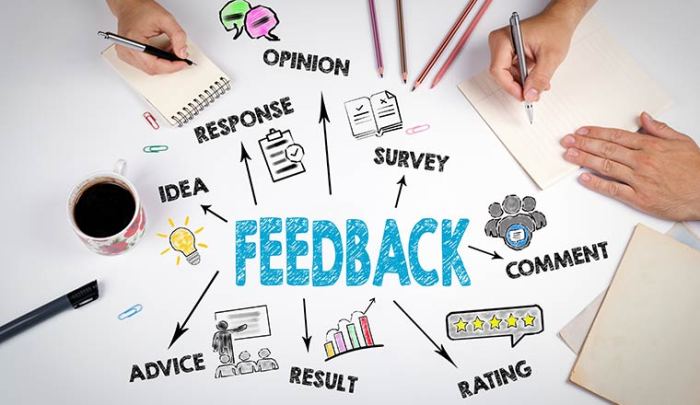Handling Customer Feedback kicks off the conversation on how businesses can thrive by listening to their customers’ thoughts. From the impact of feedback on growth to strategies for collection and response, this topic is all about maximizing customer insights.
Importance of Customer Feedback
Customer feedback is like a goldmine for businesses, providing valuable insights into customer preferences, satisfaction levels, and areas for improvement. By listening to what customers have to say, businesses can tailor their products or services to meet customer needs effectively.
Enhancing Product Development
Customer feedback plays a crucial role in improving products or services. For example, if a customer suggests a new feature for a software application, implementing that feedback can enhance the user experience and make the product more competitive in the market. Similarly, if a customer highlights a flaw in a product, addressing that issue can prevent negative reviews and improve overall customer satisfaction.
Building Customer Loyalty
Ignoring customer feedback can have a detrimental impact on business growth. Customers who feel unheard or dissatisfied are more likely to switch to a competitor, leading to loss of revenue and market share. On the other hand, businesses that actively seek and act on customer feedback can build customer loyalty and trust, ultimately driving repeat business and referrals.
Types of Customer Feedback
Customer feedback can come in various forms, each providing valuable insights for businesses looking to improve their products and services. Let’s explore the different types of customer feedback and their significance for business development.
Positive Feedback
Positive feedback is when customers express satisfaction with a product or service. This type of feedback is crucial for businesses as it highlights what they are doing right and can help boost employee morale. Businesses can use positive feedback to identify their strengths and continue to deliver exceptional customer experiences.
Negative Feedback
Negative feedback points out areas where customers are dissatisfied with a product or service. While it may be hard to hear, negative feedback is essential for businesses to identify areas of improvement. By addressing these issues, businesses can enhance their offerings and retain customers who may have otherwise taken their business elsewhere.
Constructive Feedback
Constructive feedback provides specific suggestions for improvement along with highlighting areas of concern. This type of feedback is valuable as it offers actionable insights for businesses to make meaningful changes. By implementing changes based on constructive feedback, businesses can enhance customer satisfaction and loyalty.
General Feedback, Handling Customer Feedback
General feedback encompasses overall thoughts and opinions about a product or service without specific details. While not as detailed as other types of feedback, general feedback can still offer valuable insights into customer perceptions and preferences. Businesses can use general feedback to get a broad understanding of customer sentiments and make necessary adjustments.
Strategies for Collecting Feedback
To effectively gather customer feedback, businesses can utilize various methods and channels to ensure they receive valuable insights that can help improve their products or services.
Surveys
- Surveys are a common and effective way to collect feedback from customers. They can be conducted online, through email, or even in-person.
- Make sure the survey questions are clear, concise, and relevant to gather specific feedback that can be actionable.
- Offer incentives such as discounts or freebies to encourage customers to participate in the survey.
Reviews
- Monitoring online reviews on platforms like Google, Yelp, or social media can provide valuable feedback from customers.
- Respond to both positive and negative reviews to show customers that their feedback is valued and that their concerns are being addressed.
- Encourage satisfied customers to leave reviews by making the process easy and straightforward.
Social Media Monitoring
- Keep an eye on social media channels to see what customers are saying about your brand or products.
- Engage with customers through comments, messages, or polls to gather feedback in a more interactive way.
- Use social listening tools to track mentions of your brand and identify trends in customer feedback.
Analyzing and Interpreting Feedback

When it comes to analyzing and interpreting customer feedback, it’s essential to extract valuable insights that can help businesses improve their products or services. By understanding what customers are saying, companies can make informed decisions to meet their needs and expectations effectively.
Techniques for Interpreting Feedback Data
Interpreting feedback data accurately requires careful consideration and the use of specific techniques to ensure the insights gained are meaningful and actionable. Here are some techniques businesses can use:
- Segmentation: Divide feedback into different categories based on common themes or topics to identify patterns and trends.
- Sentiment Analysis: Analyze the tone and emotions expressed in the feedback to gauge customer satisfaction levels accurately.
- Quantitative Analysis: Use numerical data, such as ratings or scores, to measure customer satisfaction and identify areas for improvement.
- Text Analytics: Utilize natural language processing tools to extract key phrases or s from feedback for deeper insights.
Using Feedback Analysis to Make Informed Decisions
Feedback analysis can provide businesses with valuable information that can guide decision-making processes and drive improvements. By understanding customer preferences, pain points, and suggestions, companies can tailor their strategies and offerings to better meet customer needs. Here are some ways businesses can use feedback analysis:
- Product Development: Use feedback to identify areas for product enhancements or new feature developments based on customer demand.
- Customer Experience Improvement: Address common complaints or issues highlighted in feedback to enhance the overall customer experience.
- Marketing Strategy Refinement: Tailor marketing messages and campaigns based on customer feedback to resonate better with the target audience.
- Competitive Advantage: Use feedback to differentiate from competitors by offering unique solutions or addressing gaps in the market.
Responding to Customer Feedback: Handling Customer Feedback

Responding to customer feedback is a crucial part of maintaining a positive relationship with your customers. It shows that you value their input and are committed to providing excellent service. Whether the feedback is positive or negative, how you respond can make a big impact on customer satisfaction and loyalty.
Best Practices for Responding to Positive Feedback
- Thank the customer for their kind words and feedback.
- Personalize your response by addressing the customer by name.
- Highlight specific details from the feedback that you appreciate.
- Encourage the customer to continue providing feedback in the future.
Guide on Handling Negative Feedback Professionally and Constructively
- Apologize for any inconvenience or issue experienced by the customer.
- Listen to the customer’s concerns and acknowledge their feelings.
- Offer a solution or compensation to address the problem and show that you are taking their feedback seriously.
- Follow up with the customer to ensure that the issue has been resolved to their satisfaction.
Examples of Companies Effectively Addressing Customer Feedback
| Company | Feedback | Response |
|---|---|---|
| Amazon | Customer received a damaged product. | Amazon immediately shipped a replacement product and offered a refund for the inconvenience. |
| Zappos | Customer was unhappy with the size of the shoes purchased. | Zappos provided free return shipping and a discount on the next purchase as a gesture of goodwill. |
| Apple | Customer experienced a technical issue with their device. | Apple offered a free repair service and extended warranty to ensure customer satisfaction. |